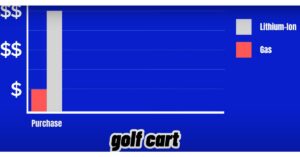Are Golf Cart Tires Tubeless?
Ever wondered about the nitty-gritty of golf cart tires? Do they function like regular car tires or have unique features that set them apart? The answer is as fascinating as it is practical!
Yes, golf cart tires are indeed tubeless. Unlike traditional bicycle tires that require an inner tube, these specialized wheels operate without one, offering a more efficient and stable ride.
But why does this matter to you as a golfer or a golf cart owner? What benefits do tubeless tires offer over their tubed counterparts? Stick around and we’ll dive into these questions and more. This knowledge could be a game-changer for your golfing experience!
Key Takeaways
- Golf cart tires have evolved to be tubeless, offering improved performance and convenience.
- Tubeless tires eliminate the need for inner tubes, reducing maintenance and potential puncture risks.
- The absence of a tube allows for better control and stability on the golf course or any terrain.
- Upgrading to tubeless tires can enhance your golf cart’s overall efficiency and longevity.
Are golf cart tires tubeless or do they require tubes?
When it comes to modern golf carts, most of them come equipped with tubeless tires. These tubeless tires have an airtight seal between the tire and wheel rim, eliminating the need for inner tubes. The absence of tubes simplifies maintenance and reduces the chances of punctures caused by pinched or damaged tubes.
Tubeless golf cart tires offer several advantages over their tubed counterparts. Firstly, they provide better stability and handling due to their ability to maintain consistent tire pressure. Secondly, they are less prone to blowouts because there is no risk of sudden air loss through a puncture in the inner tube.
However, it’s important to note that some older models of golf carts may still use tubed tires. In such cases, you will need to install inner tubes within the tire for proper inflation and functionality.
How to determine if your golf cart tires are tubeless.
If you’re unsure whether your golf cart tires are tubeless, there are a few simple ways to find out. Let’s take a closer look at the following aspects that can help you determine if your golf cart tires have tubes or not:
Check the Sidewall
Start by examining the sidewall of your golf cart tire. Look for markings or labels that indicate whether it is tubeless or requires a tube. The term “tubeless” may be explicitly mentioned, but keep an eye out for phrases like “no tube required” or “tube-type.”
Valve Stem Type
Another clue lies in the valve stem of your tire. Tubeless tires typically have shorter and straighter valve stems compared to those with tubes, which tend to have longer and curved valve stems.
Inflate and Monitor
Inflate your golf cart tire to its recommended pressure level and monitor it closely over time. If it maintains air pressure without any noticeable loss, chances are it is tubeless since tubes can sometimes leak air slowly due to punctures or aging.
Seek Professional Advice
If you’re still uncertain after inspecting your tires, consider seeking professional advice from a golf cart mechanic or contacting the manufacturer directly. They will be able to provide accurate information based on the specific make and model of your golf cart.
Can you convert tube-type golf cart tires to tubeless?
Tubeless tires have become increasingly popular in the world of golf carts due to their numerous benefits. They offer improved traction, reduced maintenance, and a smoother ride. But what if your golf cart currently has tube-type tires? Is it possible to convert them to tubeless?
The answer is yes, it is indeed possible to convert tube-type golf cart tires to tubeless. However, there are a few important factors you need to consider before making this conversion.
- Firstly, you will need the appropriate rim for a tubeless tire. Tube-type rims are not designed to hold air directly; they rely on an inner tube for that purpose. So, if you want to switch from tubes to tubeless, you’ll need new rims specifically made for tubeless tires.
- Secondly, it’s crucial to ensure that your current tire size is compatible with the new rims. The size of your tire should match the recommended specifications provided by the manufacturer of both your golf cart and the new rims.
- Lastly, when converting from tubes to tubeless tires, it’s essential to pay attention during installation. Proper mounting and sealing techniques are necessary for ensuring an airtight fit between the tire and rim.
Advantages and disadvantages of using tubeless golf cart tires.
Tubeless golf cart tires have become increasingly popular due to their advantages, but they also come with certain disadvantages. Here are some of the key points to consider:
Advantages:
- Reduced Flat Tires: One of the primary advantages of tubeless tires is their ability to resist punctures and reduce the risk of flat tires. Since there is no inner tube, there’s less chance of a sudden loss of air.
- Self-Sealing Technology: Many tubeless tires are equipped with self-sealing technology. This means that if a small puncture occurs, the sealant inside the tire automatically fills the hole, preventing air from escaping and maintaining tire pressure.
- Lower Maintenance: Tubeless tires generally require less maintenance compared to traditional tube-type tires. They are less prone to pinch flats, and the absence of a tube eliminates the need for regular tube replacement.
- Better Performance: Tubeless tires can enhance the performance of the golf cart. They provide a more consistent and even pressure across the tire, which can contribute to better stability and handling.
- Weight Savings: Since there is no inner tube, tubeless tires are often lighter than their tube-type counterparts. This reduction in weight can contribute to improved fuel efficiency and overall performance.
Disadvantages:
- Initial Cost: Tubeless tires tend to be more expensive upfront compared to tube-type tires. However, this cost difference may be offset by the long-term savings in maintenance and repairs.
- Complex Installation: Mounting tubeless tires can be more complex than installing tube-type tires. It may require additional equipment and expertise, and improper installation could lead to issues.
- Compatibility Issues: Some older golf carts may not be designed to accommodate tubeless tires. In such cases, modifications may be necessary, adding to the overall cost and complexity.
- Sealant Drying Out: The sealant inside tubeless tires can dry out over time, especially in hot climates. This can reduce the effectiveness of the self-sealing technology and may require the addition of new sealant.
- Limited Repair Options: While tubeless tires can often be repaired, the size and location of the puncture may limit repair options. In some cases, replacement may be necessary.
What maintenance is required for tubeless golf cart tires?
Keeping your tubeless golf cart tires in good condition is crucial for a smooth and enjoyable ride on the course. By following some simple maintenance steps, you can extend the lifespan of your tires and ensure optimal performance. Let’s explore what maintenance is required for tubeless golf cart tires.
Regularly Check Tire Pressure
Maintaining proper tire pressure is essential to prevent unnecessary wear and tear on your tires. Use a reliable pressure gauge to check the pressure regularly, as recommended by the manufacturer. Underinflated or overinflated tires can affect traction, stability, and fuel efficiency.
Inspect Tread Wear
Regularly inspecting the tread wear of your golf cart tires will help you identify any signs of uneven wear or damage that may require attention. Look out for cuts, bulges, or excessive wearing in specific areas of the tire surface. If you notice any irregularities, it may be time to replace the tire.
Keep Tires Clean
Dirt and debris accumulated on your golf cart tires can lead to premature aging and deterioration. To keep them clean, simply use mild soap and water to wash off any dirt after each round of golf or when necessary.
Store Properly During Off-Season
If you won’t be using your golf cart during certain seasons, it’s important to store it properly to preserve the life of your tubeless tires. Park your golf cart in a cool, dry place away from direct sunlight or extreme temperatures that could cause rubber degradation.
Rotate Tires Regularly
Rotating your golf cart tires at regular intervals helps distribute wear more evenly across all four wheels instead of concentrating it on one area only – extending their overall lifespan.
FAQs
Q: Do golf cart tires require tubes?
A: No, most modern golf cart tires are tubeless and do not require an inner tube. However, some older models may still use tubes.
Q: What are the advantages of tubeless golf cart tires?
A: Tubeless tires offer several benefits, including reduced risk of punctures or blowouts, easier maintenance as there is no need to check or replace tubes, and improved overall performance due to better tire pressure stability.
Q: Can a tube be used in a tubeless golf cart tire?
A: It is generally not recommended to use a tube in a tubeless golf cart tire. The design and construction of these tires are specifically intended for direct contact with the rim without the need for an additional inner tube.
Q: How can you tell if a golf cart tire is tubeless?
A: Tubeless golf cart tires typically have a specific marking on the sidewall indicating “tubeless” or “TL.” Additionally, if there is no valve stem protruding from the wheel when it is removed, it is likely that the tire is indeed tubeless.





